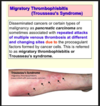Chapter 19: The Pancreas Flashcards
What is the most common congenital anomaly of the pancreas?
What occurs embryologically?
- Pancreas Divisum
- Failure of fusion of fetal duct system of the dorsal and ventral pancreatic primordia

In Pancreas Divisum the bulk of the pancreas (formed by dorsal primordium) drains through where?
Through the small-caliber minor papilla

Annular pancreas is caused by what?
Can lead to what complication?
- A band-like ring of normal pancreatic tissue completely encircles the 2nd portion of the duodenum
- Can produce duodenal obstruction
Very rarely the pancreas fails to develop (agenesis) and sometimes is due to germline mutation involving which gene?
PDX1
*‘P’ for pancreas!
In Western countries which 2 factors account for the majority of acute pancreatitis?
- Biliary tract disease
- Alcoholism
Pancreatic duct obstruction leading to acute pancreatitis is most commonly due to?
What are 4 other risk factors that cause obstruction?
- Gallstones = most common
- Periampullary neoplasms
- Choledochoceles
- Parasites —> Ascaris lumbricoides + Clonorchis sinensis
- Possible pancreas divisum
Local fat necrosis in acute pancreatitis is caused by what?
Lipase is produced in an active form –> local fat necrosis
Which ion plays a key role in regulating trypsin activation?
Ca2+
How do low Ca2+ levels vs. high Ca2+ levels have an affect on trypsin?
- High Ca2+ –> loss of autoinhibition = trypsin activation
- Low Ca2+ –> trypsin cleaves and inactivates itself = inactivation
How does primary acinar cell injury play a role in the pathogenesis of acute pancreatitis?
i.e., role of oxidative stress, what’s activated and which TF’s expressed
- Oxidative stress may generate free radicals –> membrane lipid oxidation + activation of TF’s such as AP1 and NF-kB
- Increased Ca2+ flux leads to increased Trypsin
Alcohol consumption causes a transient increase in the contraction of what?
Sphincter of Oddi
Which 3 metabolic disorders are implicated in the development of acute pancreatitis?
- Hypertriglyceridemia
- Hypercalcemic states
- Hyperparathyroidism –> increased Ca2+
Which virus has been linked to pancreatitis?
Mumps - Paramyxovirus - ssRNA virus
Hereditary pancreatitis due to a trypsinogen mutation has what type of inheritance pattern?
Which gene is mutated and is it a loss or gain of function?
- Autosomal Dominant
- Gain-of-function in PRSS1 (chromosome 7) –> Trypsinogen gene
Hereditary pancreatitis can also be caused by a loss-of-function mutation in which gene?
Inheritance pattern of this mutation?
- SPINK1 (chromosome 5) –> encodes a trypsin inhibitor
- Autosomal recessive
How do mutations in the CFTR gene lead to potential duct obstruction and the development of pancreatitis?
Decreased HCO3- secretion by ductal cells –> promotes protein plugging + duct obstruction
In the milder form, acute interstitial pancreatitis, what are the 3 histologic alterations seen?
- Mild inflammation
- Interstitial edema
- Focal areas of fat necrosis (due to lipase)

In the more severe form, acute necrotizing pancreatitis, what are some of the characteristic histological changes?
Which cells are necrosed?
- Necrosis of acinar and ductal tissues + islets of Langerhans
- Vascular injury –> hemorrhage into pancreatic parenchyma
What is the cardinal clinical symptom of acute pancreatitis?
Where does this pain refer to and how is it characterized?
- Abdominal pain
- Constant + intense –> referred to upper back or left shoulder
Elevated plasma levels of what support the diagnosis of acute pancreatitis?
Describe the timeline of these elevations (first 24 hours to 96 hours)?
- Elevation of amylase during the first 24 hours
- Rising lipase level by 72 to 96 hours
Full-blown acute pancreatitis is a medical emergency and how does it typically manifest clinically?
What causes the serious systemic complications and what are these complications that may be seen?
- Sudden disasterous onset of “acute abdomen”
- Release of toxic enzymes, cytokines, and other mediators into circulation —> leukocytosis, DIC, edema, and acute respiratory distress syndrome
- Shock and acute renal tubular necrosis may occur
What is the key to management of someone who presents with acute pancreatitis?
“Resting” the pancreas by total restriction of oral intake and by supportive therapy w/ IV fluids + analgesia
What are 2 ominous complications that can arise with acute pancreatitis?
- Acute respiratory distress syndrome
- Acute renal failure
How does acute vs. chronic pancreatitis differ in the type of injury that occurs to the pancreatic parenchyma (ie., reversible or irreversible)
- Acute is associated with reversible injury
- Chronic is associated with irreversible injury




